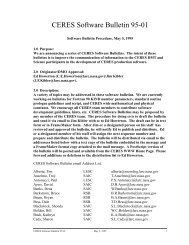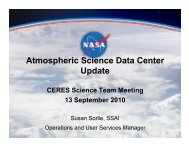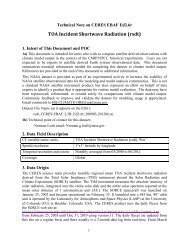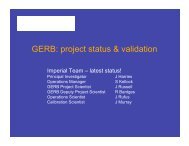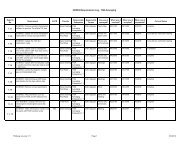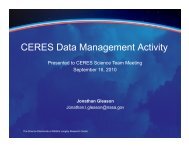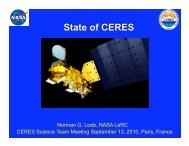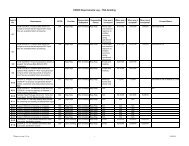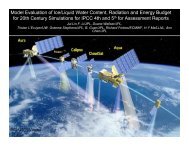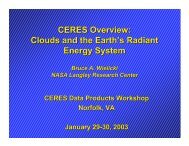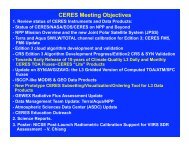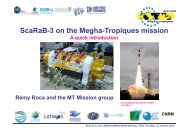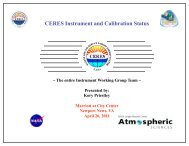CERES Instrument Overview / Calibration - NASA
CERES Instrument Overview / Calibration - NASA
CERES Instrument Overview / Calibration - NASA
Create successful ePaper yourself
Turn your PDF publications into a flip-book with our unique Google optimized e-Paper software.
<strong>CERES</strong> <strong>Instrument</strong> <strong>Overview</strong> / <strong>Calibration</strong><br />
Kory J. Priestley<br />
<strong>CERES</strong> Data Products Workshop<br />
28 January, 2003<br />
Norfolk, Virginia<br />
<strong>NASA</strong> Langley Research Center<br />
Atmospheric Sciences
Agenda<br />
Role and responsibilities of the <strong>Instrument</strong> Working Group<br />
in the <strong>CERES</strong> Project<br />
<strong>CERES</strong> <strong>Instrument</strong> <strong>Overview</strong><br />
Radiometric <strong>Calibration</strong> Goals and on-orbit performance<br />
Comprehensive on-orbit Cal/Val plan/protocol<br />
<strong>Instrument</strong> Working Group Web page demo<br />
<strong>NASA</strong> Langley Research Center<br />
Atmospheric Sciences
<strong>Instrument</strong> Working Group<br />
<br />
5 <strong>CERES</strong> instruments launched to date on 3 platforms<br />
Platform<br />
<strong>Instrument</strong><br />
Orbit<br />
Launch date<br />
TRMM<br />
PFM<br />
35-deg inclination<br />
11/27/97<br />
Terra<br />
FM1 and FM2<br />
10:45 am<br />
12/18/99<br />
Aqua<br />
FM3 and FM4<br />
1:30 pm<br />
5/4/02<br />
-<br />
FM5<br />
-<br />
-<br />
<br />
<br />
<br />
<br />
Characterize and calibrate the instrument spectrally,<br />
spatially,temporally and radiometrically<br />
Responsible for ensuring instrument performance is in<br />
consonance with all science objectives<br />
Continually looking at ways to improve measurement technology<br />
to maximize scientific return<br />
Long term goal is to minimize the dichotomy between science and<br />
engineering<br />
<strong>NASA</strong> Langley Research Center<br />
Atmospheric Sciences
<strong>CERES</strong> <strong>Instrument</strong><br />
Design is based upon the Earth Radiation Budget<br />
Experiment (ERBE) philosophy<br />
<strong>Instrument</strong> was designed, manufactured and tested by<br />
TRW (Redondo Beach, CA)<br />
Contains three sensor assemblies with cassegrain optics<br />
and thermistor bolometer detectors<br />
Sensors measure thermal radiation in the near-visible<br />
through far-infrared spectral region<br />
Three sensor channels are coaligned and mounted on a<br />
spindle which rotates about the elevation axis<br />
Hemispherical sampling obtained with an azimuthal axis<br />
drive system<br />
Channel fields of view overlap by
<strong>NASA</strong> Langley Research Center<br />
Atmospheric Sciences<br />
<strong>CERES</strong> Sensor
<strong>NASA</strong> Langley Research Center<br />
Atmospheric Sciences<br />
<strong>CERES</strong> Sensor
<strong>NASA</strong> Langley Research Center<br />
Atmospheric Sciences<br />
<strong>CERES</strong> Sensor
<strong>NASA</strong> Langley Research Center<br />
Atmospheric Sciences<br />
<strong>CERES</strong> Sensor
<strong>NASA</strong> Langley Research Center<br />
Atmospheric Sciences<br />
<strong>CERES</strong> Sensor
<strong>NASA</strong> Langley Research Center<br />
Atmospheric Sciences<br />
<strong>CERES</strong> Sensor
<strong>NASA</strong> Langley Research Center<br />
Atmospheric Sciences<br />
<strong>CERES</strong> Sensor
<strong>CERES</strong><br />
Azimuth Plane<br />
Scan Modes<br />
Fixed<br />
(FAPS)<br />
Programmable<br />
(PAPS)<br />
Rotating<br />
(RAPS)<br />
<strong>NASA</strong> Langley Research Center<br />
Atmospheric Sciences
<strong>CERES</strong><br />
Azimuth Plane<br />
Scan Modes<br />
Fixed<br />
(FAPS)<br />
Programmable<br />
(PAPS)<br />
Rotating<br />
(RAPS)<br />
<strong>NASA</strong> Langley Research Center<br />
Atmospheric Sciences
<strong>CERES</strong><br />
Azimuth Plane<br />
Scan Modes<br />
Fixed<br />
(FAPS)<br />
Programmable<br />
(PAPS)<br />
Rotating<br />
(RAPS)<br />
<strong>NASA</strong> Langley Research Center<br />
Atmospheric Sciences
<strong>CERES</strong><br />
Azimuth Plane<br />
Scan Modes<br />
Fixed<br />
(FAPS)<br />
Programmable<br />
(PAPS)<br />
Rotating<br />
(RAPS)<br />
<strong>NASA</strong> Langley Research Center<br />
Atmospheric Sciences
<strong>CERES</strong> Spectral Response Function<br />
TRMM/PFM Edition1 Data Products<br />
<strong>CERES</strong> PFM Spectral Response Functions<br />
Total Window Shortwave ERBE SW<br />
1.0<br />
Responsivity (-)<br />
0.8<br />
0.6<br />
0.4<br />
0.2<br />
0.0<br />
0.1 1 10 100<br />
Wavelength (microns)<br />
Note: LWDAY = Total - Shortwave<br />
<strong>NASA</strong> Langley Research Center<br />
Atmospheric Sciences
Radiometric Performance Requirements<br />
Spectral<br />
Regions<br />
Solar<br />
Terrestrial<br />
Atmospheric<br />
Window<br />
Wavelengths 0.3 - 5.0 µ m 5.0 - 200 µ m 8 - 12 µ m<br />
Scene Levels 100 w/m 2 -sr 100 w/m 2 -sr All Levels<br />
Accuracy<br />
requirements<br />
0.8 w/m 2 -sr 1.0 % 0.8 w/m 2 -sr 0.5% 0.3 w/m 2 -sr<br />
Requirements for <strong>CERES</strong> are more stringent than ERBE s by a factor of 2<br />
<strong>NASA</strong> Langley Research Center<br />
Atmospheric Sciences
Radiometric <strong>Calibration</strong> Facility<br />
Narrow Field of View Blackbody (NFBB) is primary<br />
standard (Emissivity of greater than 0.9999)<br />
12.5 cm Wide Field of View Blackbody (WFBB)<br />
Cold Space Reference (CSR) blackbodies<br />
New SW reference source (SWRS) with minimum<br />
LW variations and better spectral characterization<br />
5 cm i.d. integrating sphere with associated optics<br />
Cryogenically cooled Transfer Active Cavity<br />
Radiometer (TACR)<br />
Point Response Function characterization source<br />
Constant Radiance Reference to determine scan<br />
dependent offsets<br />
Earth infrared radiation simulators<br />
Liquid nitrogen cooled shroud wall<br />
<strong>NASA</strong> Langley Research Center<br />
Atmospheric Sciences
Radiometric <strong>Calibration</strong> Facility<br />
Thermally Controlled<br />
Vacuum Chamber<br />
<strong>NASA</strong> Langley Research Center<br />
Atmospheric Sciences
Radiometric <strong>Calibration</strong> Facility<br />
<strong>CERES</strong> <strong>Instrument</strong><br />
On Pedestal<br />
<strong>NASA</strong> Langley Research Center<br />
Atmospheric Sciences
Radiometric <strong>Calibration</strong> Facility<br />
Transfer Active<br />
Cavity Radiometer<br />
<strong>NASA</strong> Langley Research Center<br />
Atmospheric Sciences
Radiometric <strong>Calibration</strong> Facility<br />
Narrow & Wide<br />
Field Blackbodies<br />
<strong>NASA</strong> Langley Research Center<br />
Atmospheric Sciences
Radiometric <strong>Calibration</strong> Facility<br />
Shortwave<br />
Reference Source<br />
<strong>NASA</strong> Langley Research Center<br />
Atmospheric Sciences
Radiometric <strong>Calibration</strong> Facility<br />
Space<br />
Simulators<br />
Space<br />
Simulators<br />
<strong>NASA</strong> Langley Research Center<br />
Atmospheric Sciences
Radiometric <strong>Calibration</strong> Facility<br />
<strong>NASA</strong> Langley Research Center<br />
Atmospheric Sciences<br />
Point Response Function<br />
Measurement System
<strong>CERES</strong> Spectral Response Function<br />
TRMM/PFM Edition1 Data Products<br />
<strong>CERES</strong> PFM Spectral Response Functions<br />
Total Window Shortwave ERBE SW<br />
1.0<br />
Responsivity (-)<br />
0.8<br />
0.6<br />
0.4<br />
0.2<br />
0.0<br />
0.1 1 10 100<br />
Wavelength (microns)<br />
0.2 - 2.5 µm<br />
SWRS<br />
2.5 - >100 µm<br />
Fourier Transform Spectrometer<br />
<strong>NASA</strong> Langley Research Center<br />
Atmospheric Sciences
Mathematical Model<br />
The Spectral Response, S λ , may be mathematically modeled as<br />
where<br />
ρ λ<br />
τ λ<br />
α λ<br />
S j ≡ ρ τ α j =<br />
λ<br />
2<br />
λ<br />
λ<br />
tot,sw,wn<br />
is the spectral reflectance of the silvered mirrors<br />
is the spectral transmittance of any optical filters<br />
is the spectral absorptance of the detector<br />
λ<br />
Theoretically, the ratio of the spectral response functions of any two given<br />
channels results in cancellation of the spectral characteristics of common<br />
components, Thus<br />
S<br />
S<br />
tot<br />
λ<br />
sw<br />
λ<br />
= 1<br />
τ<br />
Practically, this is only true to the extent of repeatability in the manufacturing<br />
process<br />
λ<br />
<strong>NASA</strong> Langley Research Center<br />
Atmospheric Sciences
Shortwave Spectral Characterization<br />
(0.2 - 2.5 µm)<br />
<br />
<br />
<br />
<br />
<br />
Shortwave Reference Source (SWRS) uses filters to provide 13 narrow band<br />
sources between 0.4 and 2.0 µm<br />
A cryogenically cooled Transfer Active Cavity Radiometer (TACR) places these<br />
sources on the same radiometric scale as the Narrow Field Blackbody (NFBB)<br />
By ratioing <strong>CERES</strong> measurements to TACR measurements, the relative SW<br />
spectral response, S sw , is defined in each of these narrow spectral bands, ∆λ, for<br />
both the SW channel and SW portion of the Total channel<br />
S<br />
sw<br />
∆ λ,<br />
<strong>CERES</strong><br />
=<br />
∆λ,<br />
<strong>CERES</strong><br />
∆λ,<br />
TACR<br />
Spectral measurements of the optical components are used to complete the<br />
spectral response curve between the narrowband SW sources and extend the<br />
curve down to the UV region (0.2 µm)<br />
Component measurements from 0.2 - 2.5 µm are made using a CARY5 grating<br />
spectrometer with the witness samples in a nitrogen purged chamber<br />
m<br />
m<br />
<strong>NASA</strong> Langley Research Center<br />
Atmospheric Sciences
Determination of S λ in the Longwave region<br />
(2.5 - >100 µm)<br />
FTS Vacuum Chamber Facility<br />
<br />
<br />
<br />
<br />
BIO-RAD Fourier Transform Spectrometer 60A Dual Source/Dual Detector<br />
system with an 896 interferometer and flip mirror.<br />
The first detector is a <strong>CERES</strong> sensor, including the entire optical train.<br />
Second detector is a spectrally flat Lithium Tantalate (α > 99%) Pyro-electric<br />
Reference Detector (PRD) with a trap configuration.<br />
S λ is obtained by normalizing the transformed interferogram measurements of<br />
the <strong>CERES</strong> sensor to those of the spectrally flat reference detector...<br />
<br />
<br />
f<br />
mλ,<br />
<strong>CERES</strong><br />
Sλ =<br />
f<br />
mλ,<br />
PRD<br />
Six combinations of beamsplitter and sources are used to completely cover the<br />
IR spectral regime<br />
Beyond approximately 30 microns the SNR of the FTS data decreases rapidly<br />
<strong>NASA</strong> Langley Research Center<br />
Atmospheric Sciences
Longwave Spectral Characterization<br />
(2.5 - > 100 µm)<br />
Regressing sensor output (radiometric counts) as a function of theoretical<br />
filtered radiance, I T f , for each of the 12 calibration NFBB temperatures over<br />
the range of 205 to 315K yields<br />
Radiometric<br />
Counts<br />
Slope is the<br />
radiometric Gain<br />
Theoretical Filtered Radiance, I T<br />
f<br />
f<br />
IT<br />
=<br />
φ1<br />
θ1<br />
∞<br />
∫ ∫ ∫<br />
S<br />
λ<br />
φ= 0 θ= 0λ=<br />
0<br />
I<br />
λ,T NFBB<br />
dλdθdφ<br />
<br />
<br />
<br />
The final LW spectral response, S λ , is determined by optimizing this regression<br />
By optimizing we mean adjusting the estimate of S λ within the understood FTS<br />
measurement uncertainty such that the residuals in the regression are minimized.<br />
This methodology ensures that <strong>CERES</strong> is optimally calibrated against longwave<br />
radiance sources that have Planck like spectral distributions.<br />
<strong>NASA</strong> Langley Research Center<br />
Atmospheric Sciences
<strong>CERES</strong> <strong>Instrument</strong> Radiometric Validation Activities<br />
Product<br />
Spatial<br />
Scale<br />
Temporal<br />
Scale<br />
Metric<br />
Spectral<br />
Band<br />
Internal BB<br />
Filtered<br />
Radiance<br />
N/A<br />
N/A<br />
Absolute Stability<br />
TOT, WN<br />
On-Board<br />
Internal Lamp<br />
Filtered<br />
Radiance<br />
N/A<br />
N/A<br />
Absolute Stability<br />
SW<br />
Solar<br />
Filtered<br />
Radiance<br />
N/A<br />
N/A<br />
Relative Stability<br />
TOT, SW<br />
Theoretical Line-by-Line<br />
Filtered<br />
Radiance<br />
> 20 Km<br />
Instantaneous<br />
Inter-Channel<br />
Theoretical Agreement<br />
TOT, WN<br />
Unfiltering Algorithm<br />
Theoretical Validation<br />
N/A<br />
N/A<br />
N/A<br />
N/A<br />
TOT, SW, WN<br />
Inter-satellite<br />
(Direct Comparison)<br />
Unfiltered<br />
Radiance<br />
1-deg Grid<br />
1 per crossing<br />
Inter-<strong>Instrument</strong><br />
Agreement, Stability<br />
TOT, SW, WN<br />
Vicarious<br />
Tropical Matched Pixels<br />
(Direct Comparison)<br />
Unfiltered<br />
Radiance<br />
Pixel to Pixel<br />
Daily<br />
Inter-<strong>Instrument</strong><br />
Agreement<br />
TOT, SW, WN<br />
Tropical Mean<br />
(Geographical Average)<br />
Unfiltered<br />
Radiance<br />
20N —20S<br />
Monthly<br />
Inter-Channel<br />
Agreement, Stability<br />
TOT, WN<br />
DCC Albedo<br />
Unfiltered<br />
Radiance<br />
>40 Km<br />
Monthly<br />
Inter-<strong>Instrument</strong><br />
agreement, Stability<br />
SW<br />
DCC 3-channel<br />
Unfiltered<br />
Radiance<br />
>100 Km<br />
Monthly<br />
Inter-Channel<br />
consistency, stability<br />
TOT, SW<br />
TIme Space Averaging<br />
Fluxes<br />
Global<br />
Monthly<br />
Inter-<strong>Instrument</strong><br />
Agreement<br />
LW, SW<br />
<strong>NASA</strong> Langley Research Center<br />
Atmospheric Sciences
<strong>CERES</strong> <strong>Instrument</strong> Radiometric Validation Activities<br />
Product<br />
Spatial<br />
Scale<br />
Temporal<br />
Scale<br />
Metric<br />
Spectral<br />
Band<br />
Internal BB<br />
Filtered<br />
Radiance<br />
N/A<br />
N/A<br />
Absolute Stability<br />
TOT, WN<br />
On-Board<br />
Internal Lamp<br />
Filtered<br />
Radiance<br />
N/A<br />
N/A<br />
Absolute Stability<br />
SW<br />
Solar<br />
Filtered<br />
Radiance<br />
N/A<br />
N/A<br />
Relative Stability<br />
TOT, SW<br />
Theoretical Line-by-Line<br />
Filtered<br />
Radiance<br />
> 20 Km<br />
Instantaneous<br />
Inter-Channel<br />
Theoretical Agreement<br />
TOT, WN<br />
Unfiltering Algorithm<br />
Theoretical Validation<br />
N/A<br />
N/A<br />
N/A<br />
N/A<br />
TOT, SW, WN<br />
Inter-satellite<br />
(Direct Comparison)<br />
Unfiltered<br />
Radiance<br />
1-deg Grid<br />
1 per crossing<br />
Inter-<strong>Instrument</strong><br />
Agreement, Stability<br />
TOT, SW, WN<br />
Vicarious<br />
Tropical Matched Pixels<br />
(Direct Comparison)<br />
Unfiltered<br />
Radiance<br />
Pixel to Pixel<br />
Daily<br />
Inter-<strong>Instrument</strong><br />
Agreement<br />
TOT, SW, WN<br />
Tropical Mean<br />
(Geographical Average)<br />
Unfiltered<br />
Radiance<br />
20N —20S<br />
Monthly<br />
Inter-Channel<br />
Agreement, Stability<br />
TOT, WN<br />
DCC Albedo<br />
Unfiltered<br />
Radiance<br />
>40 Km<br />
Monthly<br />
Inter-<strong>Instrument</strong><br />
agreement, Stability<br />
SW<br />
DCC 3-channel<br />
Unfiltered<br />
Radiance<br />
>100 Km<br />
Monthly<br />
Inter-Channel<br />
consistency, stability<br />
TOT, SW<br />
TIme Space Averaging<br />
Fluxes<br />
Global<br />
Monthly<br />
Inter-<strong>Instrument</strong><br />
Agreement<br />
LW, SW<br />
<strong>NASA</strong> Langley Research Center<br />
Atmospheric Sciences
<strong>CERES</strong> Onboard <strong>Calibration</strong> Sources<br />
Internal <strong>Calibration</strong> Module (ICM)<br />
<br />
Blackbodies for the Total and Window<br />
channels<br />
<br />
Temperature knowledge obtained via<br />
Platinum Resistance Thermometers (PRTs)<br />
<br />
Quartz-halogen tungsten lamp for the<br />
Shortwave channel<br />
<br />
ICM Provides 3 unique radiance levels for the<br />
SW and LW sources<br />
<strong>NASA</strong> Langley Research Center<br />
Atmospheric Sciences
Terra/Flight Model 1<br />
Lifetime Radiometric Stability<br />
Determined with the Internal <strong>Calibration</strong> Module<br />
2.0<br />
Total Window Shortwave<br />
Gain Stability (%)<br />
1.5<br />
1.0<br />
0.5<br />
0.0<br />
Normalized to Ground<br />
<strong>Calibration</strong> Data<br />
-0.5<br />
Feb-00 Aug-00 Feb-01 Aug-01 Feb-02 Aug-02<br />
DATE<br />
<strong>NASA</strong> Langley Research Center<br />
Atmospheric Sciences
Terra/Flight Model 2<br />
Lifetime Radiometric Stability<br />
Determined with the Internal <strong>Calibration</strong> Module<br />
2.0<br />
Total Window Shortwave<br />
Gain Stability (%)<br />
1.5<br />
1.0<br />
0.5<br />
0.0<br />
Normalized to Ground<br />
<strong>Calibration</strong> Data<br />
-0.5<br />
Feb-00 Aug-00 Feb-01 Aug-01 Feb-02 Aug-02<br />
DATE<br />
<strong>NASA</strong> Langley Research Center<br />
Atmospheric Sciences
Internal <strong>Calibration</strong>s<br />
Key Results<br />
Ground to Flight <strong>Calibration</strong> Stability<br />
Determined with Internal <strong>Calibration</strong> Module<br />
TOT: 0.20 and 0.12% for FM1 and FM2<br />
WN: 0.48 and 1.3% for FM1 and FM2<br />
SW: -0.26 and 0.16% for FM1 and FM2<br />
On-Orbit <strong>Calibration</strong> Stability (%/year)<br />
Internal <strong>Calibration</strong> Module<br />
TOT: 0.125 and 0.28* %/yr for FM1 and FM2<br />
WN: -0.06 and -0.02 %/yr for FM1 and FM2<br />
SW: 0.09* and 0.08* %/yr for FM1 and FM2<br />
* statistically significant<br />
All internal calibrations have been executed in daytime portion of orbit<br />
Solar <strong>Calibration</strong>s<br />
Terra MAM s have continued to drift with time and results are suspect<br />
<strong>NASA</strong> Langley Research Center<br />
Atmospheric Sciences
<strong>CERES</strong> <strong>Instrument</strong> Radiometric Validation Activities<br />
Product<br />
Spatial<br />
Scale<br />
Temporal<br />
Scale<br />
Metric<br />
Spectral<br />
Band<br />
Internal BB<br />
Filtered<br />
Radiance<br />
N/A<br />
N/A<br />
Absolute Stability<br />
TOT, WN<br />
On-Board<br />
Internal Lamp<br />
Filtered<br />
Radiance<br />
N/A<br />
N/A<br />
Absolute Stability<br />
SW<br />
Solar<br />
Filtered<br />
Radiance<br />
N/A<br />
N/A<br />
Relative Stability<br />
TOT, SW<br />
Theoretical Line-by-Line<br />
Filtered<br />
Radiance<br />
> 20 Km<br />
Instantaneous<br />
Inter-Channel<br />
Theoretical Agreement<br />
TOT, WN<br />
Unfiltering Algorithm<br />
Theoretical Validation<br />
N/A<br />
N/A<br />
N/A<br />
N/A<br />
TOT, SW, WN<br />
Inter-satellite<br />
(Direct Comparison)<br />
Unfiltered<br />
Radiance<br />
1-deg Grid<br />
1 per crossing<br />
Inter-<strong>Instrument</strong><br />
Agreement, Stability<br />
TOT, SW, WN<br />
Vicarious<br />
Tropical Matched Pixels<br />
(Direct Comparison)<br />
Unfiltered<br />
Radiance<br />
Pixel to Pixel<br />
Daily<br />
Inter-<strong>Instrument</strong><br />
Agreement<br />
TOT, SW, WN<br />
Tropical Mean<br />
(Geographical Average)<br />
Unfiltered<br />
Radiance<br />
20N —20S<br />
Monthly<br />
Inter-Channel<br />
Agreement, Stability<br />
TOT, WN<br />
DCC Albedo<br />
Unfiltered<br />
Radiance<br />
>40 Km<br />
Monthly<br />
Inter-<strong>Instrument</strong><br />
agreement, Stability<br />
SW<br />
DCC 3-channel<br />
Unfiltered<br />
Radiance<br />
>100 Km<br />
Monthly<br />
Inter-Channel<br />
consistency, stability<br />
TOT, SW<br />
TIme Space Averaging<br />
Fluxes<br />
Global<br />
Monthly<br />
Inter-<strong>Instrument</strong><br />
Agreement<br />
LW, SW<br />
<strong>NASA</strong> Langley Research Center<br />
Atmospheric Sciences
Why Deep Convective Clouds?<br />
Narrow to Broadband Conversion<br />
Nighttime All Sky<br />
<strong>NASA</strong> Langley Research Center<br />
Atmospheric Sciences
Why Deep Convective Clouds?<br />
Narrow to Broadband Conversion<br />
Nighttime All Sky<br />
<strong>NASA</strong> Langley Research Center<br />
Atmospheric Sciences
Line by Line Radiative Transfer Code Comparison<br />
<strong>CERES</strong> on TRMM<br />
Nighttime Deep Convective Cloud Data<br />
Final Edition 2<br />
<strong>CERES</strong>/TRMM<br />
line-byline<br />
Filtered Total Channel<br />
Radiance (W/m^2/sr)<br />
34<br />
32<br />
30<br />
28<br />
26<br />
24<br />
22<br />
2 2.2 2.4 2.6 2.8 3 3.2 3.4 3.6 3.8 4<br />
Filtered Window Channel Radiance (W/m^2/sr)<br />
<strong>NASA</strong> Langley Research Center<br />
Atmospheric Sciences
<strong>CERES</strong> <strong>Instrument</strong> Radiometric Validation Activities<br />
Product<br />
Spatial<br />
Scale<br />
Temporal<br />
Scale<br />
Metric<br />
Spectral<br />
Band<br />
Internal BB<br />
Filtered<br />
Radiance<br />
N/A<br />
N/A<br />
Absolute Stability<br />
TOT, WN<br />
On-Board<br />
Internal Lamp<br />
Filtered<br />
Radiance<br />
N/A<br />
N/A<br />
Absolute Stability<br />
SW<br />
Solar<br />
Filtered<br />
Radiance<br />
N/A<br />
N/A<br />
Relative Stability<br />
TOT, SW<br />
Theoretical Line-by-Line<br />
Filtered<br />
Radiance<br />
> 20 Km<br />
Instantaneous<br />
Inter-Channel<br />
Theoretical Agreement<br />
TOT, WN<br />
Unfiltering Algorithm<br />
Theoretical Validation<br />
N/A<br />
N/A<br />
N/A<br />
N/A<br />
TOT, SW, WN<br />
Inter-satellite<br />
(Direct Comparison)<br />
Unfiltered<br />
Radiance<br />
1-deg Grid<br />
1 per crossing<br />
Inter-<strong>Instrument</strong><br />
Agreement, Stability<br />
TOT, SW, WN<br />
Vicarious<br />
Tropical Matched Pixels<br />
(Direct Comparison)<br />
Unfiltered<br />
Radiance<br />
Pixel to Pixel<br />
Daily<br />
Inter-<strong>Instrument</strong><br />
Agreement<br />
TOT, SW, WN<br />
Tropical Mean<br />
(Geographical Average)<br />
Unfiltered<br />
Radiance<br />
20N —20S<br />
Monthly<br />
Inter-Channel<br />
Agreement, Stability<br />
TOT, WN<br />
DCC Albedo<br />
Unfiltered<br />
Radiance<br />
>40 Km<br />
Monthly<br />
Inter-<strong>Instrument</strong><br />
agreement, Stability<br />
SW<br />
DCC 3-channel<br />
Unfiltered<br />
Radiance<br />
>100 Km<br />
Monthly<br />
Inter-Channel<br />
consistency, stability<br />
TOT, SW<br />
TIme Space Averaging<br />
Fluxes<br />
Global<br />
Monthly<br />
Inter-<strong>Instrument</strong><br />
Agreement<br />
LW, SW<br />
<strong>NASA</strong> Langley Research Center<br />
Atmospheric Sciences
TRMM / Terra Intercomparison<br />
Co-located Radiances using PAPS Mode<br />
<strong>NASA</strong> Langley Research Center<br />
Atmospheric Sciences
Co-located FM1/FM2 and PFM Longwave Radiances<br />
Radiance<br />
Wm -2 sr -1<br />
FM1 - PFM<br />
Wm -2 sr -1 (%)<br />
FM2 - PFM<br />
Wm -2 sr -1<br />
95% Conf.<br />
Interval<br />
Wm -2 sr -1<br />
Population<br />
Size<br />
LW Day<br />
86.5<br />
-0.4 (-0.5)<br />
-0.4 (-0.5)<br />
0.1<br />
146<br />
LW Night<br />
83.6<br />
0.1 (0.1)<br />
-0.3 (-0.4)<br />
0.1<br />
122<br />
Consistency<br />
-<br />
0.5 (0.6)<br />
0.1 (0.1)<br />
-<br />
-<br />
WN Day<br />
7.1 / µm<br />
0.01 (0.1)<br />
0.07 (1.0)<br />
0.01<br />
64/38<br />
WN Night<br />
6.6 / µm<br />
0.03 (0.5)<br />
0.10 (1.5)<br />
0.01<br />
122<br />
Consistency<br />
-<br />
0.02 (0.4)<br />
0.03 (0.5)<br />
-<br />
-<br />
March 01 - 31, 2000<br />
1-deg gridded unfiltered radiances, ∆VZA = -0.4-deg, ∆RAZ = -0.4-deg<br />
<strong>NASA</strong> Langley Research Center<br />
Atmospheric Sciences
Co-located FM1/FM2 and PFM Shortwave Radiances<br />
Radiance<br />
Wm -2 sr -1<br />
Difference<br />
Wm -2 sr -1<br />
95% Conf.<br />
Interval<br />
Population<br />
Size<br />
FM1 - PFM<br />
81.3<br />
-0.3 (-0.4)<br />
0.4<br />
Wm -2 sr -1 161<br />
123<br />
FM2 - PFM<br />
70.8<br />
-0.1 (-0.2)<br />
0.4<br />
38<br />
FM 1/2 - PFM<br />
78.8<br />
-0.3 (-0.4)<br />
0.3<br />
March 01 - April 19, 2000<br />
1-deg gridded unfiltered radiances, ∆VZA = --0.5-deg, ∆RAZ = -0.4-deg<br />
<strong>NASA</strong> Langley Research Center<br />
Atmospheric Sciences
Proposed <strong>CERES</strong>/GERB Intercalibration<br />
<strong>CERES</strong> to serve as transfer standard for GERB detectors<br />
Co-located Radiances<br />
Temporally, Spatially, Angularly<br />
matched pixels<br />
<strong>CERES</strong> PAPS Mode<br />
10-day Intensive Data Collect Period<br />
<strong>NASA</strong> Langley Research Center<br />
Atmospheric Sciences
Proposed <strong>CERES</strong>/GERB Intercalibration<br />
<strong>CERES</strong> to serve as transfer standard for GERB detectors<br />
<strong>NASA</strong> Langley Research Center<br />
Atmospheric Sciences
Intersatellite comparison<br />
Key Results<br />
Significance level in LW and WN: 0.1%, SW: 0.4%<br />
<br />
<br />
<br />
<br />
<br />
<br />
<br />
FM1 and FM2 daytime LW radiances 0.5% smaller than PFM<br />
FM1 nighttime LW radiances not significantly different from PFM<br />
FM2 nighttime LW radiances 0.5% lower than PFM<br />
FM1 WN radiances not significantly different from PFM<br />
FM2 WN radiances 0.5% higher than PFM<br />
FM1 and FM2 SW radiances not significantly different from PFM<br />
Differences are not found to be scene dependent<br />
<strong>NASA</strong> Langley Research Center<br />
Atmospheric Sciences
<strong>CERES</strong> <strong>Instrument</strong> Radiometric Validation Activities<br />
Product<br />
Spatial<br />
Scale<br />
Temporal<br />
Scale<br />
Metric<br />
Spectral<br />
Band<br />
Internal BB<br />
Filtered<br />
Radiance<br />
N/A<br />
N/A<br />
Absolute Stability<br />
TOT, WN<br />
On-Board<br />
Internal Lamp<br />
Filtered<br />
Radiance<br />
N/A<br />
N/A<br />
Absolute Stability<br />
SW<br />
Solar<br />
Filtered<br />
Radiance<br />
N/A<br />
N/A<br />
Relative Stability<br />
TOT, SW<br />
Theoretical Line-by-Line<br />
Filtered<br />
Radiance<br />
> 20 Km<br />
Instantaneous<br />
Inter-Channel<br />
Theoretical Agreement<br />
TOT, WN<br />
Unfiltering Algorithm<br />
Theoretical Validation<br />
N/A<br />
N/A<br />
N/A<br />
N/A<br />
TOT, SW, WN<br />
Inter-satellite<br />
(Direct Comparison)<br />
Unfiltered<br />
Radiance<br />
1-deg Grid<br />
1 per crossing<br />
Inter-<strong>Instrument</strong><br />
Agreement, Stability<br />
TOT, SW, WN<br />
Vicarious<br />
Tropical Matched Pixels<br />
(Direct Comparison)<br />
Unfiltered<br />
Radiance<br />
Pixel to Pixel<br />
Daily<br />
Inter-<strong>Instrument</strong><br />
Agreement<br />
TOT, SW, WN<br />
Tropical Mean<br />
(Geographical Average)<br />
Unfiltered<br />
Radiance<br />
20N —20S<br />
Monthly<br />
Inter-Channel<br />
Agreement, Stability<br />
TOT, WN<br />
DCC Albedo<br />
Unfiltered<br />
Radiance<br />
>40 Km<br />
Monthly<br />
Inter-<strong>Instrument</strong><br />
agreement, Stability<br />
SW<br />
DCC 3-channel<br />
Unfiltered<br />
Radiance<br />
>100 Km<br />
Monthly<br />
Inter-Channel<br />
consistency, stability<br />
TOT, SW<br />
TIme Space Averaging<br />
Fluxes<br />
Global<br />
Monthly<br />
Inter-<strong>Instrument</strong><br />
Agreement<br />
LW, SW<br />
<strong>NASA</strong> Langley Research Center<br />
Atmospheric Sciences
3-Channel Intercomparison<br />
GOAL<br />
Assess agreement between the SW channel and the SW portion<br />
of the Total Channel.<br />
DATASET<br />
Product: ES-8 s for the months of January-August<br />
View Zenith: Nadir footprints only<br />
Latitude: ~30 N to ~30 S<br />
Desired Scene Type: High, cold deep convective clouds<br />
Filtered Radiance Threshold:
3-Channel Intercomparison<br />
Methodology<br />
Regress Filtered Window against Unfiltered Total (i.e. LW) radiances at night.<br />
Predict daytime LW with two methods<br />
LW<br />
day<br />
= Totalday<br />
− SWday<br />
LWday = C1 ∗ WNday<br />
+ C2<br />
Difference these two estimates and plot as a function of Filtered SW, I f sw .<br />
∆LWday = (Totalday<br />
− SWday<br />
) − (C1<br />
∗ WNday<br />
+ C2)<br />
Any error in the unfiltering process (either due to errors in S λ , or in<br />
detemining the unfiltering coefficients) may be represented by<br />
error<br />
= −<br />
a<br />
lw / tot<br />
⎛ d ⎞<br />
⎜<br />
∆<br />
⎟<br />
sw<br />
dI<br />
⎝ f ⎠<br />
⎛<br />
⎜<br />
a<br />
⎝ a<br />
sw / tot<br />
* 100<br />
where the a s are the spectral unfiltering coefficients for the longwave<br />
channel (lw), shortwave channel (sw) and the shortwave portion of the total<br />
channel (sw/tot) for DCC.<br />
sw<br />
⎟ ⎞<br />
⎠<br />
<strong>NASA</strong> Langley Research Center<br />
Atmospheric Sciences
3-Channel Deep Convection Results<br />
March 2000<br />
PFM FM1 FM2<br />
Delta Daytime LW Daytime LW Error Radiance<br />
(Wm (W/m^2/sr)<br />
-2 -1 )<br />
4<br />
2<br />
0<br />
-2<br />
-4<br />
-6<br />
0 50 100 150 200 250<br />
Filtered Shortwave Radiance (W/m^2/sr)<br />
Daytime LW Error = (Total day — SW day ) — (C 1 *WN day + C 2 )<br />
Where C 1<br />
and C 2<br />
are found by regressing the Unfiltered WN against the<br />
unfiltered Total channel at night.<br />
Non-linearity in FM1 is due to SW leak in WN channel<br />
<strong>NASA</strong> Langley Research Center<br />
Atmospheric Sciences
3-Channel Intercomparison<br />
Monthly Unfiltering Error<br />
Filtered SW vs Delta LW<br />
FM1<br />
FM2<br />
0.04<br />
Slope for 0 Intercept<br />
0.03<br />
0.02<br />
0.01<br />
0<br />
-0.01<br />
-0.02<br />
Dec-<br />
99<br />
Mar-00 Jun-00 Oct-00 Jan-01 Apr-01 Jul-01<br />
Nov-<br />
01<br />
Feb-02<br />
May-<br />
02<br />
Edition 1<br />
Filtered SW vs Delta LW<br />
FM1<br />
FM2<br />
0.04<br />
Slope for 0 Intercept<br />
0.03<br />
0.02<br />
0.01<br />
0<br />
-0.01<br />
-0.02<br />
Dec-<br />
99<br />
Mar-00 Jun-00 Oct-00 Jan-01 Apr-01 Jul-01<br />
Nov-<br />
01<br />
Feb-02<br />
May-<br />
02<br />
Edition 2<br />
<strong>NASA</strong> Langley Research Center<br />
Atmospheric Sciences
DCC 3-Channel Intercomparison<br />
Key Results<br />
<br />
3-Channel Intercomparison<br />
FM-1<br />
Time varying inconsistency in FM-1 Total channel beginning 3/01 (0.5% / yr)<br />
Direct Comparison suggests error is in the SW portion of the Total Channel<br />
FM-2<br />
Time varying inconsistency in FM-2 Total channel (total change ~2%)<br />
Direct Comparison suggests error is in the SW portion of the Total Channel<br />
<strong>NASA</strong> Langley Research Center<br />
Atmospheric Sciences
Terra Edition2 BDS and ERBE-Like Summary<br />
3/00 - 9/01<br />
Actions<br />
Updated initial flight gains to account for shifts during launch.<br />
Acounted for on-orbit drifts in detector responsivites, or gains.<br />
Accounted for changes in spectral coloration of the SW/TOT channels<br />
Results (for All-Sky cases, 3/00 - 9/01)<br />
LWday<br />
LWnight<br />
SW<br />
WNday<br />
WNnight<br />
Ed2<br />
Ed1<br />
Ed2<br />
Ed1<br />
Ed2<br />
Ed1<br />
Ed2<br />
Ed1<br />
Ed2<br />
Ed1<br />
Stability<br />
W/m 2<br />
<strong>Instrument</strong> Working Group Summary<br />
<strong>CERES</strong> has successfully met or exceeded all performance goals to date<br />
Comprehensive <strong>Calibration</strong>/validation plan is in place<br />
Incorporates experiments of all temporal, spatial scales<br />
Utilizes instantaneous through zonal and regional mean data products<br />
Demonstrated ability to remove instrument drifts by an order of magnitude<br />
Nighttime LW, SW, and WN fluxes are stable at better than 0.1%/yr (Terra Ed2)<br />
Daytime LW fluxes stable at 0.2%/yr level (Terra Ed2)<br />
<strong>NASA</strong> Langley Research Center<br />
Atmospheric Sciences
http://asd-www.larc.nasa.gov/<strong>Instrument</strong>/<br />
<strong>NASA</strong> Langley Research Center<br />
Atmospheric Sciences
<strong>NASA</strong> Langley Research Center<br />
Atmospheric Sciences
<strong>NASA</strong> Langley Research Center<br />
Atmospheric Sciences
<strong>NASA</strong> Langley Research Center<br />
Atmospheric Sciences
<strong>NASA</strong> Langley Research Center<br />
Atmospheric Sciences
<strong>NASA</strong> Langley Research Center<br />
Atmospheric Sciences
<strong>NASA</strong> Langley Research Center<br />
Atmospheric Sciences
<strong>NASA</strong> Langley Research Center<br />
Atmospheric Sciences
<strong>NASA</strong> Langley Research Center<br />
Atmospheric Sciences
<strong>NASA</strong> Langley Research Center<br />
Atmospheric Sciences
http://asd-www.larc.nasa.gov/<strong>Instrument</strong>/<br />
<strong>NASA</strong> Langley Research Center<br />
Atmospheric Sciences



